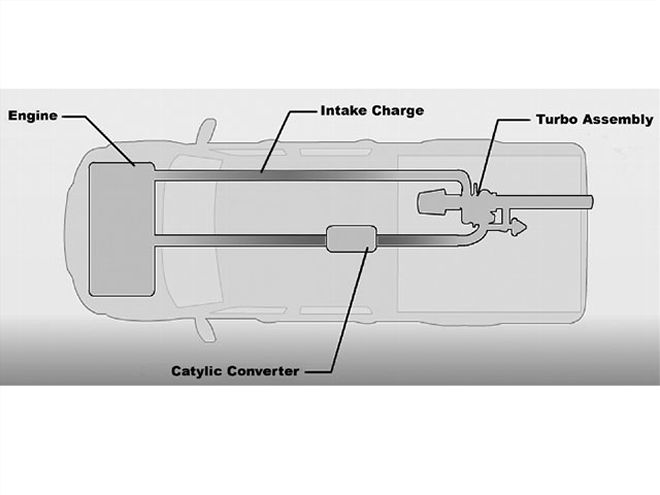

Power adders. Years ago, a supercharger was the only means of building more power. Then came nitrous oxide, but many shied away from that because they saw too many lean-condition explosions. In recent years though, turbo charging has gained quite a bit of popularity, and for good reason. A turbocharger is simply an exhaust-driven air compressor. Take a small shaft about the size of a pencil and attach a pinwheel-like fan on each end. Place the shaft in a case that separates the two pinwheels, and then send exhaust gases through one of the pinwheels (turbine). Now, the other pinwheel spins by the energy created by the turbine, and this in turn forces air from the second pinwheel (compressor) into the carburetor. When the compressed air builds pressure in the intake manifold, when the intake valves open, air is forced into the combustion chamber. We have really simplified the process here, but you get the idea. It's proven that turbo charging is beneficial, but there are drawbacks-namely, heat. Compressing air causes it to heat, and we all know that hot intake air is a bad thing. It not only raises the combustion chamber temperature and increases the chance of detonation, but also air expands as it is heated. In other words, the air will lose some of the compression effect, and the turbo must work harder to maintain the desired level of compression.
STS Turbo systems has devised a way to turbocharge an engine, and avoid the issues caused by underhood turbo mounting. Most components under the hood of today's vehicles were not designed to operate at this increased temperature caused by turbocharging. In order to place a turbo in an already overcrowded engine compartment, it is necessary to do a lot more than just make some room for the turbo itself. By mounting the turbo remotely under the vehicle, STS has eliminated the heat problem. A remote mounted turbo eliminates underhood heat, with no additional lag, and requires no major modifications to your vehicle. The basic system provides about 5 psi of boost, but with additional tuning and turbo upgrades, the systems can produce near 20 psi of boost.
Remote Mounting
We know what you're thinking, a turbo needs to be mounted close to the engine, right? Actually, mounting the turbo external of the engine compartment not only eliminates the heat issue, but since there is no need for custom turbo-mounting headers, the STS turbo systems can be installed in 4 to 6 hours with standard tools and average mechanical ability. Since your turbo is mounted outside of the engine bay, you will need to install pipe from the turbo to the intake, and that length of intake piping provides a 50-percent intercooler efficiency. That means there is no need for the expense, pressure drop, and installation problems associated with a front-mounted intercooler.
We've tried to sell you on the benefits of the STS turbo system, so now let's show how it goes together and get some horsepower numbers. We had access to a Hemi Ram pickup truck, so we decided to see how well this stuff fits. Some simple modifications will need to be handled during this install, but it's nothing that someone with a little mechanical ability can't handle.
Summary
This may not be as in depth as you will actually get with the install, but it gives you an idea about thinking unconventionally when mounting a turbo. The kit in the Hemi Ram is sufficient enough to produce 416.92 hp. That's a gain of 154 hp. thinking outside the engine bay can really boost your Ram's performance.
Remove the C-4 connector from the PCM. (Note: This is the lower plug on the computer with the GREEN connector.) Cut the yellow wire with the brown tracer, and strip the ends of the cut wires. Now install the provided electrical connectors with the female spade terminal on the wire that goes to the computer plug and the male spade connector on the wire that goes into the harness and to the transmission. Install the transmission pressure modification cable inline and reconnect the C-4 plug onto the computer. Connect the ground lead of the transmission pressure modification cable to the factory ground at the inside of the right front fender.